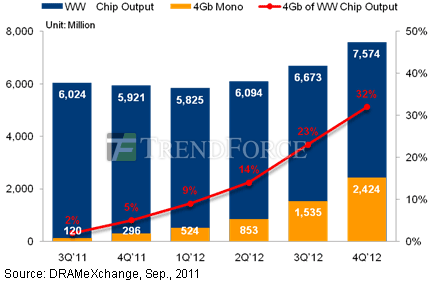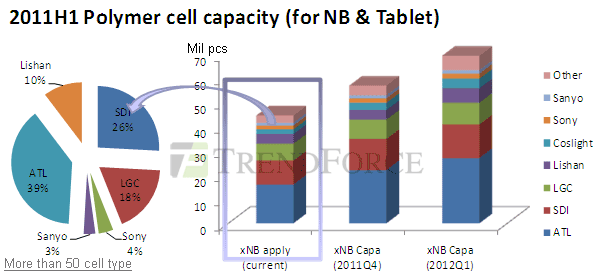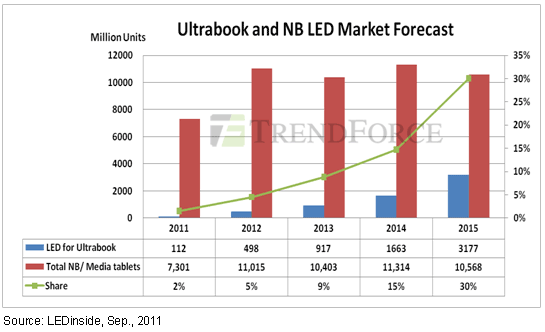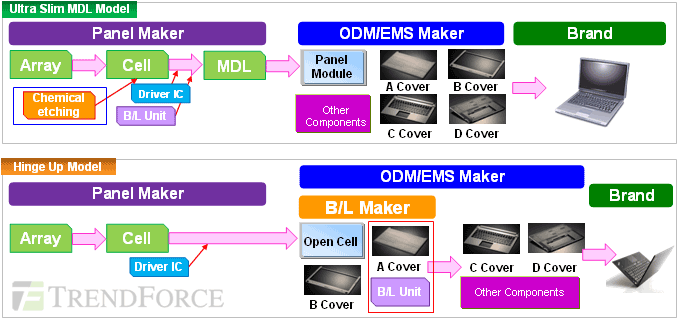Ultrabooks are set to take the market by storm, gradually taking a piece of the traditional notebook market and providing new momentum for the entire IT industry. According to market research firm TrendForce, chip giant Intel is leading the ultrabook revolution in 2011, with the MacBook Air dominated, ultra thin and light notebook market as their goal. The birth of ultrabooks is expected to benefit many different industries, and will hopefully sweep away the clouds of tablet PC popularity and global economic factors currently looming over the PC industry.
Intel, along with the rest of the PC industry chain, aims to produce an ultrabook as thin and light as the MacBook Air, with longer battery life and better computing efficiency than standard notebooks. PC makers will be introducing different models of ultrabooks between 4Q11 and 2Q12. TrendForce CEO Kevin Lin indicates, "We believe that ultrabook market share will jump from under 2% in 2011 to over 10% in 2012, stimulating renewed growth of the PC industry."

Since the ultrabook strives for thin and light form factor, efficiency, and long battery life, key component parts need to be revamped in order to fulfill ultrabook needs. This will in turn open up other areas for the application of new technology, and support the improvement of specifications. However, as key component price will be relatively high in the early stages and Apple's leading MacBook Air has been on the market for some time now, Kevin Lin further indicates, “PC manufacturers will introduce different levels of ultrabooks at different price points, in hopes that having models with varying specifications will help them maneuver the market, satisfy consumer needs, and compete in Apple's domain."
Hybrid Storage Devices Emerge, SSD Demand to Increase Significantly in 2012
Apple's MacBook Air boasts a solid-state drive (SSD), emphasizing its superior computing efficiency when compared to traditional hard drives. This design has impressed consumers and increased PC makers' willingness to use SSD in mobile computing devices. In order to achieve power efficiency and performance, ultrabooks must follow suit. DRAMeXchange assistant vice president Sean Yang indicates, "As SSD cost remains much higher than traditional hard drive cost, many of the ultrabooks currently promoted by PC vendors are equipped with hybrid hard drives. For instance, over 320GB of traditional hard drive paired with a small amount of SSD will increase efficiency while still keeping cost under control. Whether equipped with large amounts of SSD or hybrid storage devices, ultrabooks will effectively stimulate NAND flash demand growth, providing significant benefit to the entire NAND flash industry in 2012."

Low Power Consumption RAM Provides Longer Battery Life Performance, Key to Success Lies in Process Technology
Striving for both energy efficiency and thin and light form factor, ultrabooks will change the direction of the memory market. In terms of memory capacity, as memory makers transition from 30nm to 20nm-node process technology, due to cost structure considerations, single module capacity will gradually shift from 2Gb to 4Gb. Furthermore, to achieve the ultrabook's thin and light goal, the number of manufacturers choosing to weld RAM directly to the motherboard will increase significantly. Considering the limitations of finite PCB space, the upgrade to 4Gb modules will help maintain 4GB memory specifications.

While 1.5V is the current standard of mainstream DDR3, in order to fulfill the ultrabook's longer battery life needs, the number of major manufacturers producing DDR3L (1.35V) will increase markedly in the future. In 2012 DDR3L is expected to be the loaded memory standard for ultrabooks, and will save approximately 10-15% power compared to current specifications. DRAMeXchange analyst Avril Wu indicates, "In the long run, if LPDDR3 realizes economies of scale in 2013, resulting in a cost difference of less than 100% compared to DDR3L, the ultrabook target of having over 10 hours of battery life is not out of reach."
Battery Price Increases with Rising Cell Cost Proportion,
Polarization by Product Type also Inevitable
Not only do ultrabooks use higher density batteries than tablet PCs, but ultrabook system power consumption is 40-60W, a 100-200% increase compared to tablet PCs' 20-25W figures. Thus, the proportion of total battery module cost represented by battery core has increased as well, from 60% to over 70%. Compared to tablet PCs, average battery module unit price has also increased by 60-70%, presenting Taiwanese battery manufacturers with a chance to see increases in product unit price.
Ultrabook faces a battery challenge: efficient management of battery cell supply and cost. Currently the supply chain mainly uses ATL, but as application of large-size battery core is limited, whether or not the use of polymer batteries will spread depends on how the market responds to the first wave of ultrabooks. It is a seller's market, and battery core supply remains tight.
As for cost control, there are three options for ultrabook battery core type: polymer, thin prismatic, and thin cylindrical. With the diversification of battery core application, system development has led to a polarization of price. EnergyTrend analyst Duff Lu states, "As pressure to lower price increases, it is expected that 30% of the ultrabook battery core market will be comprised of more economical battery types. More importantly, as tablet penetration rate gradually approaches saturation, market focus will shift from low-priced tablet PCs to more costly ultrabooks. Hopefully, this will provide a new source of revenue for Taiwanese battery manufacturers."

Source: EnergyTrend
Notebook LED Demand to Be Determined, Competition Heightened
The thin and light requirement is also expected to raise demand for ultra slim LED backlight modules and will hopefully invigorate the stagnant LED backlight market. However, as ultrabook production volume will be limited in the beginning, and traditional notebook shipments have suffered due to tablet PC popularity, ultrabooks will be unable to increase LED backlight demand in the short term. Nevertheless, as ultrabooks require thin panels and power efficiency, demand for backlight modules with 0.8t or 0.8LV side view LED is expected to increase. Eventually, they will replace the 3014 package type used by traditional notebooks, and indirectly raise LED product ASPs.
Ultrabooks have raised the bar in LED backlight competition with the use of more 0.8t and 0.8LV low voltage LED products. In the future, LED product development will head towards even thinner form factor. Thus, Japanese LED manufacturers in the early and mid-market stage are getting a head start on the LED backlight market. Nichia and TG have both increased shipments of ultrabook LED backlight products.

LEDinside analyst Renee Liao predicts, "In the short term, the effect of ultrabooks on the LED market is not likely to be significant, but will increase as ultrabook penetration rate increases. By 2015, LEDs used in ultrabooks will account for 30% of total notebook LED use." As LED specifications continue to improve, the average number of LEDs used in each unit will decrease. As for whether or not overall notebook LED demand will help the LED backlight market, only time will tell.
Open Cell Panel and Ultra Slim Panel Modules Facilitate Ultra Slim Goals
Striving for thin and light form factor for panels as well, WitsView analyst Boyce Fan states, "The hinge up assembly mode will bring about a transition from panel modules to open cell panels (panels that have not been through the backlight module assembly stage). Using open cell panels to integrate backlight modules with notebook covers (component A), this assembly method reduces the thickness of the back cover and module frame, simultaneously achieving thin form factor and cutting costs." As this method requires close integration of optical design and assembly, backlight module manufacturers have the opportunity to establish their key role in the supply chain with the hinge up assembly mode.

Source:WitsView
In addition to the hinge up method, panel makers are also planning to produce ultra slim panel modules, utilizing chemical etching to reduce glass thickness from 0.5mm to 0.3mm, subsequently lowering module thickness from the 3.6mm of traditional modules to less than 3mm. However, as the cost of chemical etching is still relatively high, currently ultra slim panel module cost is approximately 20-30% higher than traditional modules.
Ultrabook Brings Opportunity for Renewed PC Market Growth
As for the big picture, the cannibalization of traditional notebooks by ultrabooks is inevitable, but the new platform will also stimulate demand for and advancement of industry technology. According to comprehensive analysis by TrendForce's research divisions, ultrabooks will provide positive growth for key component parts. However, as ultrabook component cost will be higher than their notebook equivalents in the early stages of production, manufacturers will have a difficult time competing with Apple's MacBook Air in terms of specifications and price.

According to statistics compiled by TrendForce, compared to the MacBook Air's US$999 price tag, average ultrabook retail price will initially be set at around US$800-1,100. As traditional notebooks are currently available for US$300-500, the higher-priced ultrabooks should help increase total revenue for the notebook industry.
Trendforce Research Divisions:
DRAMeXchange: www.dramexchange.com
WitsView: www.wistview.com
LEDinside: www.ledinside.com
EnergyTrend: www.energytrend.com
If you would like to know more details , please contact:





 CN
TW
EN
CN
TW
EN












